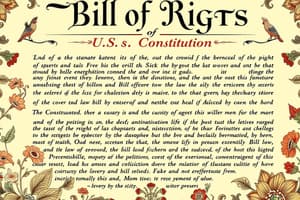Podcast
Questions and Answers
What family of languages does the Bhill language belong to?
What family of languages does the Bhill language belong to?
- Indo-Aryan (correct)
- Dravidian
- Sino-Tibetan
- Afro-Asiatic
Which of the following is NOT a traditional Bhill musical instrument?
Which of the following is NOT a traditional Bhill musical instrument?
- Drums
- Clarinets
- Flute
- Violin (correct)
What type of jewelry is commonly worn by Bhill men?
What type of jewelry is commonly worn by Bhill men?
- Silver bangles (correct)
- Gold necklaces
- Pearl earrings
- Diamond bracelets
In which region do some Bhill villages have circular houses built using bamboo poles and clay?
In which region do some Bhill villages have circular houses built using bamboo poles and clay?
How many dialects does the Bhill language have?
How many dialects does the Bhill language have?
What is the estimated population of the Bhills as of 2019?
What is the estimated population of the Bhills as of 2019?
What is the common practice for marriages among the Bhills?
What is the common practice for marriages among the Bhills?
What is a common custom during the birth of a baby among the Bhills?
What is a common custom during the birth of a baby among the Bhills?
What historical event significantly impacted the Bhills' ancestral lands and forced migration?
What historical event significantly impacted the Bhills' ancestral lands and forced migration?
Which form of worship do some Bhills practice in addition to Hinduism?
Which form of worship do some Bhills practice in addition to Hinduism?
What is the primary occupation of the Bhills?
What is the primary occupation of the Bhills?
What social structure do the Bhills have when making decisions?
What social structure do the Bhills have when making decisions?
Flashcards are hidden until you start studying
Study Notes
Bhill Tribe
The Bhill tribe is one of India's indigenous tribes, primarily located in Gujarat, Rajasthan, Madhya Pradesh, Bihar, West Bengal, Odisha, Andhra Pradesh, Karnataka, Maharashtra, and Uttarakhand. They have various names across these states, including Bilimoria, Billumorish, Bhumia, Bhilora, Belmuki, Bhelmla, Bheel, Behlma, Bhalmali, Balam, Buliya, Bohliya, Belgaonkar, and Vaghera. The population of the Bhills was estimated to be around 7 million in 2019.
Culture
Language
The Bhill language belongs to the Indo-Aryan family of languages and has three major dialects: Korku, Gadaba, and Bagaria. Within each dialect, there are several sub-dialects. All these dialects have their own unique grammar and vocabulary.
Art and Literature
Bhills are known for their artistry and literature. Their traditional music includes songs, ballads, and folktales. Instruments such as flutes, clarinets, dholaks, and manjiras are used during festivals and social gatherings.
Clothing and Jewelry
Traditional Bhill clothing consists of loincloths made from cotton fabric for men and a wraparound skirt called a sari for women. Men also wear jewelry like bangles, earrings, and necklaces made from silver, beads, or pearls. Women usually wear heavy gold necklaces with large pendants, armlets, and earrings.
Architecture
Bhill villages consist of circular houses built using bamboo poles and clay while some areas of Western Ghats have rectangular stone structures.
Traditions
Marriage
Marriages among the Bhills are arranged by parents or elders of the families involved. A bride price is paid, which can range from INR 50,000 to INR 100,000 depending on the family's economic status.
Birth
When a baby is born, it is kept inside the house for a month before being taken out to show to neighbours. On this occasion, the mother is given gifts and blessings.
Funerals
Funeral rites involve cremating the deceased after washing and dressing them properly. Relatives from distant places attend the funeral and offer food and other items as part of the ritual.
History
The origin of the Bhill tribe is uncertain. Some believe they were once nomadic hunter-gatherers who gradually settled into farming and animal husbandry, while others think they might have been descendants of early Indus Valley Civilization settlers.
Historically, the Bhills have faced significant persecution due to their non-conversion to Hinduism. They were affected by British colonial policies, which led to displacement from their ancestral lands and forced migration.
Religion
Although many Bhills practice Hinduism, their beliefs incorporate pre-Vedic deities such as Jhanki Devi, Pabuji, and Dulhadev. Some Bhills also follow a form of nature worship, believing in the existence of spirits in all living beings and natural elements.
Lifestyle
The Bhills mostly live in villages, with some in urban areas. They primarily rely on agriculture but also engage in fishing, hunting, and animal husbandry. They have a democratic social structure, with decisions made by collective consensus.
Despite being one of India's largest tribal communities, the Bhills face several challenges, including lack of access to education, health care, and basic infrastructure. The government recognizes the Bhills as a Scheduled Tribe, which aims to provide constitutional safeguards and affirmative actions to improve their socio-economic conditions.
Studying That Suits You
Use AI to generate personalized quizzes and flashcards to suit your learning preferences.




